The Early ISI Years: A Firsthand Account from the Hardware Team

Prior to founding USC Viterbi’s Information Sciences Institute (ISI), Keith Uncapher and his team were designing computer/human interfaces at the RAND Corporation. It was ground-breaking work, and it positioned them well for the challenges they’d soon face at ISI, namely: helping to create and scale the ARPAnet (the precursor to the Internet), and figuring out how humans would interact with it.
Keith’s hardware team was part of the group that spun-out of RAND to form ISI in March 1972. From the start, it was clear that most of the hardware required to build the ARPAnet and to support human interaction would have to be created. The founding members of the ISI hardware team included machinist and mechanical designer George Dietrich, machinist Oralio (Shorty) Garza, design engineers Raymond Mason and myself.
Connecting ISI to the ARPAnet
During the first couple years, the goal was to establish ISI as a major host system on the ARPAnet network, which involved establishing a computer center on the twelfth floor of ISI connecting large computers to the network. These computers were generically called PDP-10s, short for Programmed Data Processors1. The machines along the walls in the image above are PDPs.
Digital information traveled in small clusters (known as “packets”) over the dedicated phone lines which formed the ARPAnet. Interface Messaging Processors2 (IMPs) were located at each major center, including ISI, and they managed the packet traffic over those phone lines.
The IMP was the portal to the ARPAnet and each computer needed a piece of custom-designed hardware – the host interface – which allowed the computer to interact with the network through the IMP. Individual sites, including ISI, designed and produced the host interfaces for themselves, based on specifications from the IMP designer3.
I designed interfaces for several generations of PDP-10 mainframe computers4 and eventually mini computers5. One of the my interface designs was so successful it was transferred to Digital Equipment Corporation (DEC) for commercialization.
On a personal note, to facilitate the transfer of the ISI host interface design, I traveled to the DEC facility in Maynard, Massachusetts to give a technical briefing. As a young engineer I remember being so impressed with VIP status when flown by DEC’s Bell Jet Ranger helicopter from the private area of Logan airport to the landing pad at the Maynard facility.
Drumming Up More Memory
In addition to creating host interfaces, the ISI hardware team also designed an interface between the PDP-10 memory system and a paging drum. A paging drum was a device used to improve system memory performance. Main memory (RAM) was fast but limited in size, so programs that required more memory to operate could be supported by swapping “pages” of data in and out of main memory on demand. The specific drum used at ISI had 1.8 million words with 2.2 microsecond access time (a thumb drive today is roughly 100 times larger and more than 100 times faster). The drum interface was designed while the team was at RAND and transitioned with the team in the fall of 1972. The paging drum was sealed in a helium filled atmosphere to ensure that no dust or corrosion could interfere with the operation. The helium was provided by a tank stored under the unit. The drum operated until 1975 when the helium supply became depleted.
The First Networked Printer
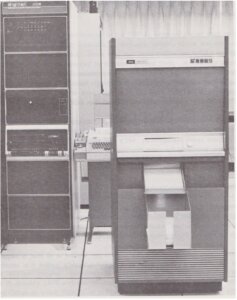
Xerox Graphics Printer at ISI showing the PDP-11 interface to the left and a teletype machine in the background.
The Xerox Graphics Printer (XGP) project provided high-quality single sheet document printing capability over a network. In mid-1974, XGP systems were installed at ISI and at ARPA. (ARPA, the Advanced Research Projects Agency, later became DARPA, is a government agency that facilitates technology research).
They were connected to the ARPAnet and to put the resulting printing capabilities in perspective, at that time, the most common mechanical printers6 were limited to around 10 characters per second. They used paper rolls, were very noisy, and supported only a single fixed-space font.
With the XGP, for the first time it was possible to transmit a document over the network to be printed remotely on high quality single sheet paper using a choice of proportionally spaced fonts. Prior to the XGP, printers produced fixed space fonts (e.g., the letter “I” and the letter “c” would each use the same amount of horizontal space on the page).
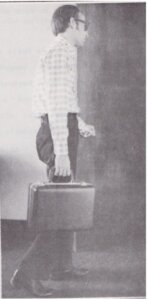
Research scientist Richard Bisbey with the portable terminal.
The First “Laptop”
In July 1973, if a remote user wished to read their email, they had to have access to a terminal connected through a phone line to an ARPAnet host. There was no wireless connectivity to the ARPAnet.
Terminals supporting remote or portable access to the ARPAnet were limited to suitcase size, displayless, thermal printers. ISI designed and built a brief case size remote access terminal which included a full-sized keyboard, 8 lines by 32 character display and an acoustic modem. Acoustic modems limited in bandwidth to around 1000 bits per second (compared to around 10 million bits per second with 5G cell phones today), were the only standard interface to the phone system.
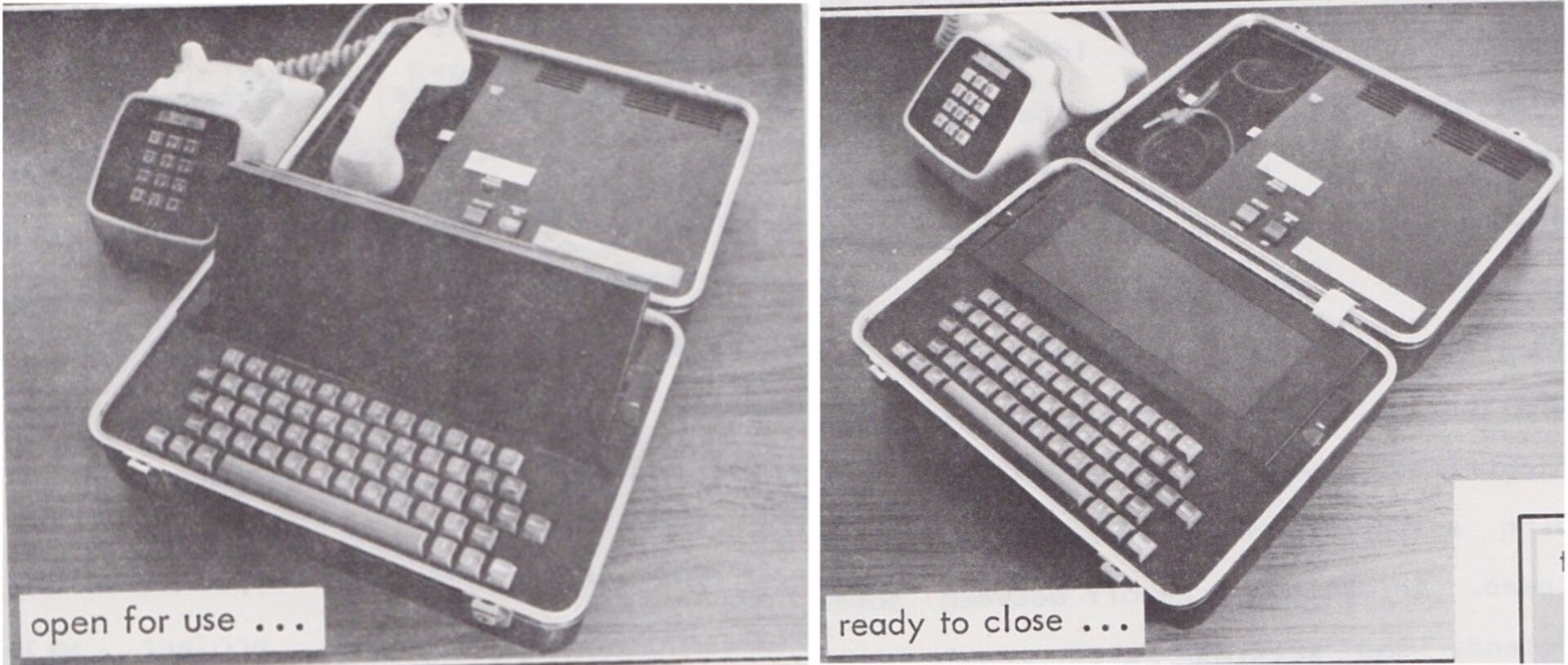
ISI Portable Terminal
Advancing the Mouse
In the late 1970s, computer input devices called “mice,” which had been invented in the 1960s, had evolved into mechanical devices that either rolled on a rubber ball or had an “x” and a “y” wheel where one or the other or both moved depending on the direction of mouse movement.
I produced what may have been the first optical mouse which still used “x” and “y” wheels but the movement was encoded optically by sensing light transmitted through slits in transparent wheels creating pulse trains representing movement. This simplified the interface by alleviating the need for an analog to digital converter port and reduced the maintenance cleaning involved with mice rolling on balls. The ISI mouse still had the disadvantage of one or the other wheel being dragged depending on the direction of travel. This was overcome in 1980 when the first optical mice with no moving parts were invented by others.
Groundbreaking Research on Networked Speech and Video
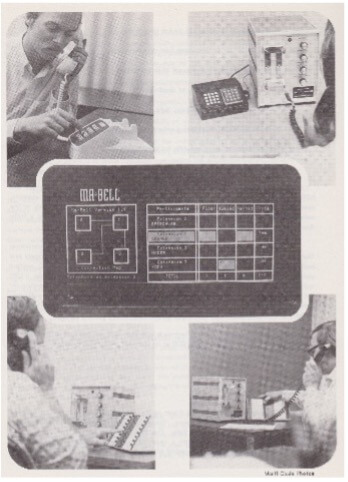
ISI ARPAnet packet voice conferencing control console
In the 1970s, telephone calls were routed through switching centers where relays connected calls across dedicated wires, this is known as “circuit switching.” These physically connected paths were dedicated for the duration of each call. There were a finite number of relays and wires so “busy” signals resulted when circuits were not available to complete a call. Voice signals traveled both ways across the same two wires and thus formed a half-duplex connection (e.g., a caller couldn’t hear while speaking).
The ARPAnet transmitted packets of digital information where packets shared the same “wire.” So, in 1972 ISI researchers believed that it was possible to packetize voice and send it just like any other data to a remote location – the aforementioned “packet switching.” What wasn’t known was whether there would be latency or capacity issues (e.g., would it be slow) resulting from packet collisions and re-transmissions within the network.
In 1972 and 1973, ISI researchers used a system to simulate ARPAnet message delays and their effect on continuous voice communication. At first this was a simulation, not actually sending data over the ARPAnet. Two researchers could talk to one another over the simulated ARPAnet between sound booths. The research quickly moved to the actual ARPAnet as it became feasible to send continuous real-time voice over a network. The ISI research was groundbreaking, and resulted in enabling protocols, voice encoding hardware, and control circuitry for sending voice over a network.
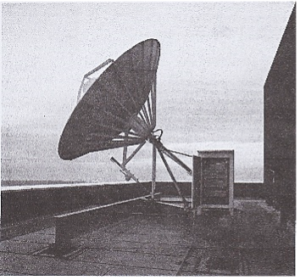
ISI wide-band satellite Earth station
Several critical milestones followed including: voice protocol development in 1974, ISI local point-to-point voice conferencing in 1975, and network voice conferencing protocol in 1976. These milestones7 were supported by several generations of encoders and control consoles, designed by me, that established connections and directed control flow.
As the research moved to wide band and a satellite dish was installed on the roof of ISI, the additional bandwidth supported pulse code modulation (PCM) algorithms for speech encoding which complied with the industry standard for digital telephony.
The Birth of Voice Over IP
By the late 1970s, the ARPAnet was moving from just connecting computers to also connecting people. I designed the Switched Telephone Network Interface8 (STNI) in 1980, a 7-inch square that was perhaps the most significant early hardware design created at ISI.
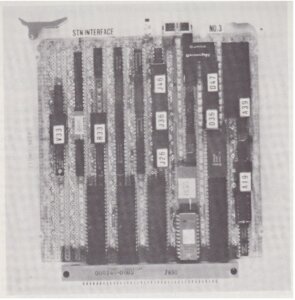
Switched Telephone Network Card (STNI) connected the traditional analog phone system to the packet switched ARPAnet.
This circuit connected the conventional telephone (circuit switched) system to the (packet switched) ARPAnet system. This card became “prior art” which prevented companies from later attempting to patent Voice Over IP (VOIP). Several of these cards were produced and sent to other participating ARPAnet sites. They were interfaced to voice terminals and supported demonstrations of voice connections that, for example, originated on a standard push-button phone calling a local STNI card which connected anywhere on the ARPAnet digitally to another STNI card which in turn could call a local phone on the conventional network. Thus, local analog calls could be routed over the ARPAnet across the country and converted back to analog close to the destination phone eliminating toll charges.
This was the beginning of treating speech as data rather than an analog signal. Today, wi-fi calling and VOIP providers are commonplace allowing, for example, cell phone users to route voice calls over the internet via apps like WhatsApp.
Hardware Development Lab
Around 1980, the Hardware Development Lab was founded as an internally funded entity at ISI, supporting sponsored research projects. I managed the lab. Lab engineers designed and produced hardware until the lab was externally funded in 1990 by a DAPRA and FBI contract. (The FBI was interested in rapid prototyping of advanced electronics.) The lab later became ISI Division 9 and was managed by John Granacki when I moved to DARPA under an Interagency Personnel Agreement in 1992.
A Full-Page Vertical Screen
Early display terminals, predecessors to the desktop workstations, had lower display resolution which limited the number of lines of text that could be displayed to 24. In the late 1970s, it was common for display terminals to be horizontally oriented (landscape mode) displays of 24 lines of 80 characters9.
Standard printed pages are vertically oriented (portrait mode) and typically have roughly 50-60 lines of text. So, when editing documents, it was not possible to show a full page of text on these early display terminals. This limitation made editing documents difficult.
In 1980, ISI combined the latest emerging high-resolution commercial monitor technology with a commercial microprocessor-based terminal to produce a full screen, portrait mode raster scan10 terminal.
The terminal displayed a nominal 54 lines of text, depending on the font size, which allowed the user to see a full page of text exactly as it would be printed on an 8.5” x 11” page. The terminal was built using the lower half (the electronics and bus without the display) of an existing Hewlett Packard terminal11 and a high-resolution cathode ray tube display mounted in portrait mode12.
To construct the terminal, the top half of the terminal was removed; George Dietrich designed a custom vacuum-formed cover to house the monitor which was fitted to its base. A custom circuit board was designed and built by Jeffrey LaCoss of the Hardware Development Lab; it contained the electronics to drive the higher resolution display. These terminals were so popular that they sat on the desk of every ISI researcher.
Faxes Get Packetized
Around 1980, fax machines were the size of modern clothes washing machines. Faxes were sent over the conventional phone system between connected fax machines. That is, to send a fax, the operator had to dial up a remote fax machine, perhaps incurring toll charges, and wait while the two machines synchronized. As the document was fed into the originating machine it was synchronously printed out on the distant machine. The transmission process was analog using audible tones to encode the data.
ISI procured one of these traditional fax machines13 and I designed an interface to the ARPAnet. Instead of sending the scan data over a phone line, the data was digitized and incorporated into a file which could be stored, printed or sent over the ARPAnet to a remote user on demand.
The power of packet switching was that everything was simply data: voice, video, fax streams, it was all the same. It is very likely that the first faxes sent over the ARPAnet were sent from the ISI installation.
The Beginning of Video Conferencing
In the 1980s, after demonstrating network voice conferencing and fax transmission, ISI turned to the task of implementing video transmission to create a video conferencing capability. The primary challenge was that video transmission required too much bandwidth, and compression techniques had to be invented.
The discrete cosine transform (DCT) was a new method for image compression that had recently been invented, and ISI wired this technique into a hardware board called the discrete cosine transform engine.
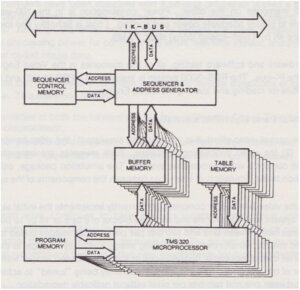
ISI Discrete Transform Engine parallel processor video codec
The idea was to build a flexible and programmable video compression engine. The architecture, which used multiple Texas Instruments digital processing chips in a parallel architecture, was novel. ISI engineer Jeff LaCoss of the Hardware Development Lab designed the single board that carried all the chips. It generated so much heat that it was known as the “toaster oven”. It was built to support what were probably the first packet video experiments via the packet satellite network between ISI and Lincoln Labs in Massachusetts.
The satellite earth station installed on the roof of ISI is shown in the adjoining photo. The transmission of video over the network required more bandwidth than the dedicated telephone lines of the early ARPAnet could provide, so the ARPAnet became satellite based. Encoding reduced the video bandwidth requirements often at the cost of video quality.
By the late 1980s, several companies influenced by this demonstration implemented commercial products and created video encoding standards based on the DCT.
Technology That Led to E-Readers
In the early 1980s, liquid crystal displays were commercially available, but ARPA was interested in the feasibility of something similar, but that would use significantly less power: a passive reflective display. In fact, in contrast to LCDs, the reflective display could retain an image without consuming any power.
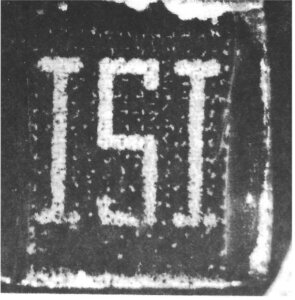
“ISI” spelled out on the electrophoretic display.
The application of electrophoretics offered the possibility of creating such a device. Electrophoretics refers to the use of an electric field to move dispersed particles in a fluid.
Rick Shiffman of ISI used a blue fluid with suspended white titanium dioxide particles. The particles could be moved through the fluid under the application of an electric field. Changing the polarity of the field would bring the white particles to the front surface where they were visible or move them to the back where they disappeared in the fluid. By localizing electric fields within a grid array, a field of pixels was created where each pixel could be independently controlled.
As proof of concept, ISI engineers designed a custom integrated circuit with electronic drivers for an array of tiny metal plates or pixel sites. The fluid/particle mixture was held in place above the chip by a seal and covered by a transparent metalized cover plate.
This was likely the first demonstration of a display that would retain its contents without any power being applied. Electrophoretic display technology continued to evolve and eventually became popular with the release of the Kindle E-reader in 2007.
Military Message Experiment
In 1972, ARPA became interested in the possibility of using ARPAnet technology to replace the military’s manual message handling system at CINCPAC headquarters in Oahu, Hawaii. At that time, messages arrived and were printed on paper, sorted manually, and distributed. ISI conducted a study of the existing system and, in 1973, proposed a system architecture based on ARPAnet technology that would provide the security, text editing, scalability and performance required by the CINCPAC operation.
An experimental system was deployed to CINCPAC around 1980. I designed the terminal customizations required by the experiment users. An HP terminal14 was adapted for the project with two significant modifications. The CRT shell was modified to accommodate status lights which indicated the system security level of the terminal. And the firmware had to be made loadable onsite because of security concerns. The usual approach would’ve been to store firmware in read-only memory (ROM), however the security environment required that the firmware be written into electrically programmable read-only memory (EPROM). The challenge was that the power supply, power distribution, and cooling available in the HP terminal was insufficient to power the EPROM boards.
I invented a novel approach of using the board select signal to switch the power on a selected board only during the time required for the memory access. High power switching field effect transistors (FETs) delivered the power pulse so rapidly that very little impact on the memory access time was incurred and allowed the system to use as many EPROMs as required by the application. Use of ARPAnet technology for command and control would go on to have a huge impact on the ability to manage urgent situations.
Solving the Dusty Deck Problem
With all those network-focused innovations, it might be surprising to hear that one of the most significant computer design efforts at the beginning of ISI was not in direct support of the ARPAnet at all.
In the early 1970s, companies spent significant funds on developing software that became obsolete with every release of a newer generation computer. Programs were coded by punching patterns in paper cards with one instruction per card. The cards were kept in boxes with each box containing hundreds of cards. The card boxes were called “decks”. These boxes of cards would be inserted into a card reader to program a mainframe computer. (I remember renting time at $100/hour on a room-sized IBM mainframe computer in 1968 where I fed my cards into the card reader and waited for the line printer to output the result).
Card decks were customized to a specific machine and although there were “standardized” languages, it was commonplace for the decks to fail to run on newer models of mainframe computers. This obsolescence was referred to as the “dusty deck” problem. In 1972, ISI acquired a Standard Computer Corporation prototype microprogrammed processor, the MLP-900.
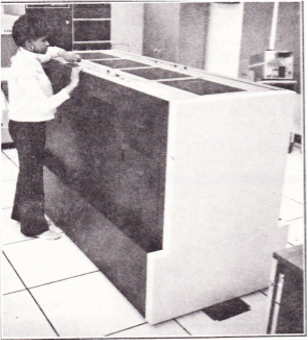
Early ISI-er Wanda Canillas at the MLP-900 in the 12th floor ISI computer room.
The dusty deck problem was the motivation for the MLP-900, which could emulate instruction set architectures from previous generation machines or from machines yet to be developed. In fact, the MLP-900 could not only emulate previous generation machines but could execute “dusty decks” faster than the original machine. Since a user could define the machine architecture that their deck was created for, they could continue to run decks that would have become obsolete without the MLP-900 emulation engine.
Although it was created by Standard Computer Corporation, ISI engineer Ray Mason made several significant hardware modifications to the machine, including a new control store, improved cooling, and improved power distribution. It was supported by a high level language and a programming environment which supported remote users via the ARPAnet.
Although the hardware emulation approach to solving the dusty deck problem was unique, it was never commercially viable. There were likely three reasons for this. First, the speed of execution of computers improved rapidly by factors of 10, which allowed software emulation. Second, languages and programming standards were improved. And third, card decks disappeared when programs could be written and edited online.
Final Thoughts from Bob Parker
Those early years of ISI were a remarkable time in recent history where dedicated and sustained funding, very little bureaucratic process or burdensome oversight, inspired mentors and leaders, and very bright scientists and engineers contributed to a common goal across two decades.
As a young engineer, I was in the right place at the right time, and although none of us realized where the adventure would lead, every day was a new technical challenge driving a remarkable rate of innovation. This early ARPA community work, including ISI innovation, led to change that impacted the lives of almost every person on the planet. From this experience, I have come to realize that following the path less traveled can be most rewarding.
1 PDP-10s were produced by Digital Equipment Corporation (DEC).
2 Designed and produced by the engineering firm Bolt Beranek and Newman (BBN).
3 BBN provided specifications
4 KA-10, KI-10, and KL-10
5 DEC’s PDP-11/40 and PDP-11/45
6 Teletype electromechanical terminals such as the Teletype Corporation Model 33 machines were the principal input/output device for DEC computers.
7 Specifically, demonstrations of Network Voice Protocol in June 1974, 8 kilobit CVSD packet voice in September 1974, ISI local point-to-point conferencing in 1975, Linear Predictive Coding demo (3.5 kbps) January 1976, Network Voice Conferencing Protocol in January 1976
8 A Z80 microprocessor-based interface card designed on a 7-inch square printed circuit board
9 These were microprocessor based by Hewlett Packard (HP), among others.
10 There were two types of screens being used at the time, ISI focused on raster scan screens.
11 The HP 2645
12 From Clinton Electronics
13 A Rapicom 450 fax machine
14 The HP 2640
Published on March 9th, 2023
Last updated on May 16th, 2024